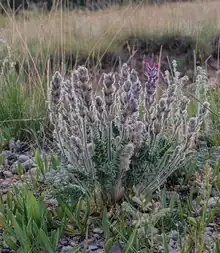Oxytropis splendens
Oxytropis splendens, commonly known as showy locoweed, is a flowering perennial in the legume family. It is native to Canada, Alaska, several Great Plains states, and parts of the Mountain West.[1]
| Oxytropis splendens | |
|---|---|
 | |
| Scientific classification | |
| Kingdom: | Plantae |
| Clade: | Tracheophytes |
| Clade: | Angiosperms |
| Clade: | Eudicots |
| Clade: | Rosids |
| Order: | Fabales |
| Family: | Fabaceae |
| Subfamily: | Faboideae |
| Genus: | Oxytropis |
| Species: | O. splendens |
| Binomial name | |
| Oxytropis splendens | |
Description
This plant is tufted with silvery, silky-hairy, leafless stems. When in bloom, it grows dense spikes of rich lavender flowers, rising from among pinnately compound basal leaves.[2] It has a lifespan of 3-5 years, blooming every year from late-June to mid-August.[3] It produces small brown seeds.[4] The plant's flowers are favored by many varieties of bumblebees.[5]
Distribution and habitat
Widely distributed in the mountains and foothills in Alberta. Alaska, Yukon, District of Mackenzie, to Lake Superior, south to southeastern British Columbia, New Mexico, North Dakota, northern Minnesota, and Colorado. It favors grassy slopes, open woods, clearings, gravelly river flats, banks, and roadsides. O. splendens is an early colonizer of disturbed gravel areas and unamended coal spoils. Its nitrogen fixing properties and quick colonizing of poor soils make it a favorable plant for revegetation.[6]
Toxicity
It is potentially toxic, as it contains toxic alkaloids and takes up selenium.[3]
References
- "Oxytropis splendens". Plants of the World Online. Royal Botanic Gardens, Kew.
- "Lady Bird Johnson Wildflower Center - The University of Texas at Austin". www.wildflower.org. Retrieved 2023-08-26.
- Smreciu, A.; Wood, S.; Gould, K. (2013-12-09). "Oxytropis splendens: showy crazyweed, showy locoweed, showy pointvetch". ERA. doi:10.7939/r3p843x4m. Retrieved 2023-08-26.
- "USDA Plants Database". plants.usda.gov. Retrieved 2023-08-26.
- Ratz, David. "Showy Locoweed - Montana Field Guide". fieldguide.mt.gov. Retrieved 2023-08-26.
- Pahl, M. D.; Pahl, M. D.; Smreciu, Elizabeth Ann; Alberta; Council, Alberta Research (1999). Growing native plants of western Canada : common grasses & wildflowers. Edmonton: Alberta Agriculture, Food and Rural Development. ISBN 978-0-7732-6138-9.